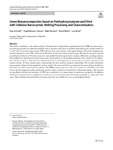Mostrar o rexistro simple do ítem
Green bionanocomposites based on polyhydroxybutyrate and filled with cellulose nanocrystals: melting processing and characterization
| dc.contributor.author | Schmidt, Anja | |
| dc.contributor.author | Bittmann‑Hennes, Birgit | |
| dc.contributor.author | Montero, Belén | |
| dc.contributor.author | Wetzel, Bernd | |
| dc.contributor.author | Barral, Luis | |
| dc.date.accessioned | 2023-10-17T16:28:52Z | |
| dc.date.available | 2023-10-17T16:28:52Z | |
| dc.date.issued | 2023-05-27 | |
| dc.identifier.citation | Schmidt, A., Bittmann-Hennes, B., Montero, B. et al. Green Bionanocomposites Based on Polyhydroxybutyrate and Filled with Cellulose Nanocrystals: Melting Processing and Characterization. J Polym Environ 31, 4801–4816 (2023). https://doi.org/10.1007/s10924-023-02835-9 | es_ES |
| dc.identifier.issn | 1572-8919 | |
| dc.identifier.uri | http://hdl.handle.net/2183/33779 | |
| dc.description | Financiado para publicación en acceso aberto: Universidade da Coruña/CISUG | es_ES |
| dc.description.abstract | [Abstract]: This article contributes to the understanding of biobased and biodegradable polyhydroxybutyrate (PHB) bionanocomposites melt processed by pre-industrial methods such as extrusion and injection molding and reinforced by weight contents of 1 and 3 wt% of cellulose nanocrystals (CNC) derived from waste streams of the paper industry. Ultrasonic treatment was used for dispersion of the CNC, which was followed by transmission electron microscopy. The thermal properties and the crystallization behavior of bionanocomposites were studied by thermogravimetric analysis, differential scanning analysis, X-ray diffraction and polarized optical microscopy. Investigations on the bending properties were carried out in conjunction with the analysis of their dynamic mechanical behavior. Scanning electron microscopy was used to characterize the fracture surface. All these analyses give a deep insight into their structure-property relationship. The moisture absorption measurements and gas barrier properties analysis made to the processed bionanocomposites have provided an insight into their behavior under environmental conditions. The PHB bionanocomposites with a low content of 1 wt% CNC were found to have the best dispersion quality, which had a positive effect on almost all mechanical and thermal properties. The increase in crystallinity with the incorporation of CNC also contributed to an improvement in mechanical properties. In ddition, the bionanocomposites show a slightly lower tendency to absorb moisture and better barrier properties to oxygen and water vapor. These findings showed that these bionanocomposites are suitable for use in the packaging industry. | es_ES |
| dc.description.sponsorship | Xunta de Galicia. Consellería de Cultura, Educación, Formación Profesional e Universidades; : ED-431 C 2019/1 | es_ES |
| dc.language.iso | eng | es_ES |
| dc.publisher | Springer | es_ES |
| dc.relation.uri | https://doi.org/10.1007/s10924-023-02835-9 | es_ES |
| dc.rights | Attribution 4.0 International | es_ES |
| dc.rights.uri | http://creativecommons.org/licenses/by/3.0/es/ | * |
| dc.subject | Bionanocomposites | es_ES |
| dc.subject | Cellulose nanocrystals | es_ES |
| dc.subject | Poly(3-hydroxybutyrate) | es_ES |
| dc.subject | Mechanical properties | es_ES |
| dc.subject | Thermal behavior | es_ES |
| dc.subject | Barrier properties | es_ES |
| dc.title | Green bionanocomposites based on polyhydroxybutyrate and filled with cellulose nanocrystals: melting processing and characterization | es_ES |
| dc.type | info:eu-repo/semantics/article | es_ES |
| dc.rights.access | info:eu-repo/semantics/openAccess | es_ES |
| UDC.journalTitle | Journal of Polymers and the Environment | es_ES |
| UDC.volume | 31 | es_ES |
| UDC.startPage | 4801 | es_ES |
| UDC.endPage | 4816 | es_ES |
| dc.identifier.doi | https://doi.org/10.1007/s10924-023-02835-9 |
Ficheiros no ítem
Este ítem aparece na(s) seguinte(s) colección(s)
-
CIT-GP - Artigos [8]






